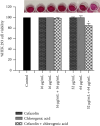Efficacy of Chlorogenic Acid Combined With Cefazolin Against Methicillin-Resistant Staphylococcus aureus Biofilms
- PMID: 40612274
- PMCID: PMC12226163
- DOI: 10.1155/cjid/6755742
Efficacy of Chlorogenic Acid Combined With Cefazolin Against Methicillin-Resistant Staphylococcus aureus Biofilms
Abstract
Background: Methicillin-resistant Staphylococcus aureus (MRSA), has the ability to cause biofilm associated chronic infections with a high mortality rate. This creates a demand for the improved antibiofilm therapies. The aim of this study was to evaluate the anti-MRSA and antibiofilm activity of a natural product, chlorogenic acid, in synergy with an antibiotic, cefazolin. Material and Methods: The synergistic effect was measured by the checkerboard method. The antibiofilm activity was analysed by crystal violet staining, MTT assay, and atomic force microscopy (AFM). The cytotoxic effect on Human Embryonic Kidney (HEK 293) cells was determined using the MTT assay. Assays were performed in triplicate, and compared using the one-way ANOVA test. Results: When chlorogenic acid and cefazolin were combined at low concentrations, a strong biofilm inhibition in terms of biofilm biomass (88%), and metabolic activity (82%) was observed, as compared to the results obtained for each compound alone. AFM images of biofilms, treated with chlorogenic acid combined with cefazolin, revealed a high destruction of biofilms and extracellular polymeric substances, as compared to each drug alone. A nontoxic effect on HEK 293 cells was observed for the combination of chlorogenic acid and cefazolin. Conclusion: Chlorogenic acid can be used as an adjuvant with currently used antibiotic in the development of combinatory therapies to treat biofilm-associated bacterial infections.
Copyright © 2025 Borel Ndezo Bisso et al. Canadian Journal of Infectious Diseases and Medical Microbiology published by John Wiley & Sons Ltd.
Conflict of interest statement
The authors declare no conflicts of interest.
Figures



References
-
- Chimi L. Y., Noubom M., Bisso B. N., Singor Njateng G. S., Dzoyem J. P. Biofilm Formation, Pyocyanin Production, and Antibiotic Resistance Profile of Pseudomonas aeruginosa Isolates From Wounds. International Journal of Microbiology . 2024;2024(1):p. 1207536. doi: 10.1155/2024/1207536. - DOI - PMC - PubMed
-
- Bisso Ndezo B., Tokam Kuaté C. R., Dzoyem J. P. Synergistic Antibiofilm Efficacy of Thymol and Piperine in Combination With Three Aminoglycoside Antibiotics Against Klebsiella pneumoniae Biofilms. The Canadian Journal of Infectious Diseases & Medical Microbiology . 2021;2021:1–8. doi: 10.1155/2021/7029944. - DOI - PMC - PubMed
-
- Chimi L. Y., Bisso B. N., Njateng G. S. S., Dzoyem J. P. Antibiotic-Potentiating Effect of Some Bioactive Natural Products Against Planktonic Cells, Biofilms, and Virulence Factors of Pseudomonas aeruginosa. BioMed Research International . 2023;2023(1):p. 9410609. doi: 10.1155/2023/9410609. - DOI - PMC - PubMed
LinkOut - more resources
Full Text Sources
Miscellaneous

